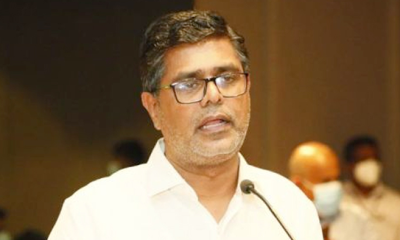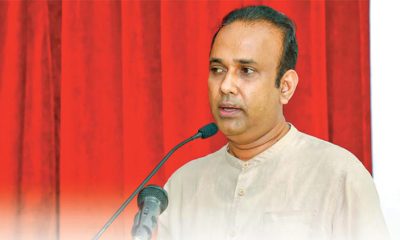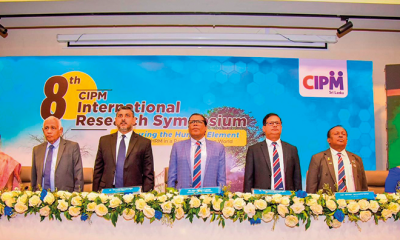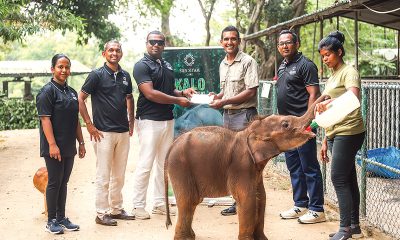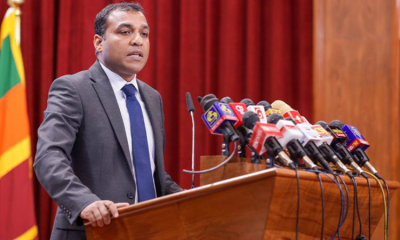Features
Recent earth tremors around Victoria dam – a scientific explanation in relation to the tectonic history of Sri Lanka

By Dulip Jayawardena
(Retired Economic Affairs Officer United Nations ESCAP 1990 to 2003 Former Director Geological Survey Department- Present GSMB (1983-1986)
Earth tremors were reported in the print and electronic media on 29 August and also 2 September 2020 in an area surrounding the Victoria dam in Kandy. The Geological Survey and Mines Bureau (GSMB) the designated Agency to monitor such earth tremors have mobilized geologists to investigate the damages caused by such earth movements.
The Director General of the GSMB announced that there had been no records of such tremors in the Pallekelle seismic monitoring station which is close to the areas affected. However, a senior Director who is a geologist gave a different version and reported that tremors were detected at the monitoring station.
The reporting of earth tremors and earthquakes are on the Richter scale, which has been revised many times. According to this scale unit 1 records a micro tremor not felt or felt rarely and the frequency of occurrence worldwide is several million per year. The scale 2 -2.9 is felt slightly by some people and damage to buildings and the worldwide frequency per year is over 1 million. The magnitude 3 to 3.9 is a minor tremor often felt by people but very rarely causes damage. Shaking of indoor objects can be noticed. The frequency is over 100,000 per year. The magnitude 4.0 -4.9 is noticeable with the shaking of indoor objects and ratting noises and felt by most people in the affected area and slightly felt outside and generally causes minimal damage. Moderate to significant damage very unlikely. Some objects may fall off shelves or be knocked over and the frequency worldwide is 10,000 15 000 per year.
Tectonic evolution of Sri Lanka theories of three peneplains and upliftment and plate tectonics
The earlier theory of the three peneplains was proposed by Wadia in the late 1948 when he was the Director of the Mineralogy Department. His theory was based on the ring of waterfalls around the country that were caused by erosion of the rocks to the upper plain mid plain and the lower plain.
However, in 1974 after a gravity survey was conducted by the Geological Survey Department (Present GSMB ) covering the entire island and it was conclusively proved that the there was an upliftment of the Precambrian terrain composed of over 80 per cent of the land area which had earlier being recognized as the Highland and Vijayan Series.
The Gravity Map of Sri Lanka on the scale of 1:100000 was published with an explanation as Professional Paper No 3 with T Hatherton, D. B. Pattiarachchi and V. V. C. Ranasinghe. This was possible with technical cooperation by the Government of New Zealand under the Colombo Plan.
During the gravity survey, earlier trigonometrical stations established by the Survey Department on the triangular survey for the topographical maps were reopened. It was then noticed that some bench marks for these stations were uplifted especially in the hill country of the island.
The most significant revelation was a significant gravity low continuously identified between the eastern boundary of the Highland and Vijayan series rocks. This led to the theory of plate tectonics where the Vijayan series sank below the Highland series forming a convergent plate boundary.
The evidence for such activity can be seen in the change of course of the Mahaweli river from a direction of north east to north as indicated by some Buddhist shrines such as Somawathi and Deegawapi which were earlier on the banks of this river.
Earth tremors are noted frequently along this fault line and geologists together with geophysicists should constantly monitor such movements.
A new tectonic plate boundary between
Australia and India
Many researchers have carried out extensive studies on the development of a new tectonic plate boundary in the Indian Ocean which occurred over 40 million years ago. This boundary that runs east west is about 400-500 kms south of Sri Lanka. If this boundary is activated it will have devastating effects to the infrastructure south of Sri Lanka such as the Hambantota Port, Mattala Airport and industrial zones envisaged in the area.
Danger to Victoria concrete arch
dam from earth tremors
Victoria dam is the largest concrete dam in Sri Lanka built under the Mahaweli Project costing Rs 9.8 billion during 1980-1984 to solve problems as hydropower for the country diversion of water for agriculture, solving unemployment, encouraging inland fisheries and flood control.
“Victoria Dam is a double curvature (cupola) arch dam of 122 meters maximum height and 520 meters crest length. The arch dam is constructed with the individual crown cantilevers. A large amount of water load acting on the upstream surface of the dam is transferred to the abutment by arch action and a certain amount of water load is transferred to the foundation by cantilever action. The destruction of the Victoria dam can cause flooding up to Trincomalee affecting the livelihood of the area .crack was identified and it has been developing in the downstream face of the Victoria dam (Sri Lanka Head works Division of Mahaweli Authority 2014)Therefore the Victoria Dam is investigated to identify the effect of earthquake ” (Ref Assessment of Concrete Arch dam under Possible Earthquake Loading in Sri Lanka Case Study on Victoria Dam by Shobitha Tharamarajah and Kamal Karunananda International Journal of Scientific and Engineering Research Volume 8 Issue 10 October 2017 ISSN 2229-5518)”
Another article titled “Comprehensive monitoring of Victoria Dam /Civil + Structural Engineer magazine <https://csengineermag.com/comprehensive-monitoring-of- victor…. > should also be studied.
All interested parties should access these excellent articles as it covers all aspects of strengthening the Victoria dam to avoid any major catastrophe.
Reservoir induced earthquakes –application to arch and gravity dams in Sri Lanka
As stated above, the only large concrete arch dam in Sri Lanka is the Victoria dam, which was built mainly for the supply of hydroelectricity. Another concrete arch dam is Canyon producing hydroelectricity.
Apart from the Victoria dam there are dams built for irrigation and hydroelectricity throughout Sri Lanka which are gravity concrete dams. There are also embankment dams constructed mainly for irrigation.
The gravity dams constructed mainly for generation of hydroelectricity are at Bowatenna, Broadlands, Castlereigh Dyraaba, Kalu Ganga, Kotmale, Kukule Ganga,Laksapana, Maskeliya, Moragahakanda, Moragolla Norton ,Nilambe, Polgolla Puhulpola, Rantambe, and Upper Kotmale Ganga,
(Ref Dams and reservoirs of Sri lanka –Wikipedia< https://en.wikipedia.org/wiki/List_of _dams_and reservoirs_in _…)
It is asked whether the gravity dams constructed mainly in the hill country are being monitored for any tremors using the latest seismic equipment as at Victoria as reservoirs of these dams will also be subject to reservoir triggered seismicity giving rise to earth tremors or earthquakes.
It is also noted that most of the above reservoirs are located in areas with less inhabitants and the tremors will not be felt as at Victoria.
Dams in Sri Lanka are built on valleys that have formed by active erosion with recent theory of upliftment as indicated by the gravity survey covering the island. It is also known that under compressional tectonic force reverse or thrust faults produce upliftment giving rise to tremors
It is known that reservoir induced seismicity can also occur after a few years and will depend on the permeability of the rocks beneath the reservoir.
It is also noted that indused earthquakes at reservoirs experience delayed triggering at depths of 10 to 20 kilometers. Such earthquakes may occur 10 to twenty years after filling the reservoir. In this regard it is noted that the Victoria reservoir was filled in 1985 which is 35 years ago.
Further the other gravity dams also should be subject to regular monitoring for any tremors due to reservoir triggered seismicity. However, it is not easy to predict reservoir induced seismicity due to the state of stress and the rock strength at earthquake depths are not subject to direct measurement.
Ref : Dams and earthquakes –Seismology Research Centre
(https://www.src.com.au/earthquakes/seismology-101/dams-eart .. )
Recommendations
In the above article I have attempted to explain the recent earth tremors experienced in the valley surrounding the Victoria Dam as well as the high ground which occupied by villagers. These tremors were felt on two occasions and the GSMB has mobilized a number of geologists to investigate what damages have been caused to the dwellings etc. A retired Professor of Geology of the Peradeniya University has attributed the tremors to the extensive quarrying operations carried out for limestone in an area above the Victoria dam.
The GSMB is also investigating the triggering of these tremors due to the Victoria reservoir indused seismicity which I have also dealt above.
With my past experience as a geologist who mapped the area in the late 1970s there are many fold belts with prominent fault zones that could be activated with gradual upliftment of the terrain as proved by the gravity survey conducted in 1975.
It is important to monitor the other gravity dams I have listed as with age of these dams the pore pressure will increase at depths to kilometers beneath the reservoir.
I urge the government to appoint a multidisciplinary team of experts comprising of geologists , geophysicists, hydrologists, civil engineers and those from the NBRO as well as the universities to study the state of the Victoria dam as well as other gravity dams and recommend an effective method of monitoring such tremors.
I had been involved in advising the late Dr A. N. S. Kulasinghe on the problems involved in the construction of the Upper Kothmale gravity dam in a landslide prone area. However it is now opportune to monitor any seismicity and take remediable measures.
As revealed above the Victoria dam developed a crack on the downstream part in 2014 and is important that constant monitoring should be carried out .
I was also involved in following up the construction of the Victoria dam in early 1980 when the then Professor of Geology of the Peradeniya University revealed that a major fault zone runs along the axis of the dam. However, the consultant engineers responded that the Victoria dam was designed to take a wave crest of 10 meters over the dam and there is no danger to its stability.
I hope this article will be helpful to the experts to draw up a comprehensive long term plan to monitor our gravity dams that mainly generate hydroelectricity as well provide water for irrigation.
Last but not least the effects of climate change on these reservoirs and the surrounding areas should not be ignored .
(The author can be reached at fasttrack@eol.lk )
Features
The heart-friendly health minister

by Dr Gotabhya Ranasinghe
Senior Consultant Cardiologist
National Hospital Sri Lanka
When we sought a meeting with Hon Dr. Ramesh Pathirana, Minister of Health, he graciously cleared his busy schedule to accommodate us. Renowned for his attentive listening and deep understanding, Minister Pathirana is dedicated to advancing the health sector. His openness and transparency exemplify the qualities of an exemplary politician and minister.
Dr. Palitha Mahipala, the current Health Secretary, demonstrates both commendable enthusiasm and unwavering support. This combination of attributes makes him a highly compatible colleague for the esteemed Minister of Health.
Our discussion centered on a project that has been in the works for the past 30 years, one that no other minister had managed to advance.
Minister Pathirana, however, recognized the project’s significance and its potential to revolutionize care for heart patients.
The project involves the construction of a state-of-the-art facility at the premises of the National Hospital Colombo. The project’s location within the premises of the National Hospital underscores its importance and relevance to the healthcare infrastructure of the nation.
This facility will include a cardiology building and a tertiary care center, equipped with the latest technology to handle and treat all types of heart-related conditions and surgeries.
Securing funding was a major milestone for this initiative. Minister Pathirana successfully obtained approval for a $40 billion loan from the Asian Development Bank. With the funding in place, the foundation stone is scheduled to be laid in September this year, and construction will begin in January 2025.
This project guarantees a consistent and uninterrupted supply of stents and related medications for heart patients. As a result, patients will have timely access to essential medical supplies during their treatment and recovery. By securing these critical resources, the project aims to enhance patient outcomes, minimize treatment delays, and maintain the highest standards of cardiac care.
Upon its fruition, this monumental building will serve as a beacon of hope and healing, symbolizing the unwavering dedication to improving patient outcomes and fostering a healthier society.We anticipate a future marked by significant progress and positive outcomes in Sri Lanka’s cardiovascular treatment landscape within the foreseeable timeframe.
Features
A LOVING TRIBUTE TO JESUIT FR. ALOYSIUS PIERIS ON HIS 90th BIRTHDAY

by Fr. Emmanuel Fernando, OMI
Jesuit Fr. Aloysius Pieris (affectionately called Fr. Aloy) celebrated his 90th birthday on April 9, 2024 and I, as the editor of our Oblate Journal, THE MISSIONARY OBLATE had gone to press by that time. Immediately I decided to publish an article, appreciating the untiring selfless services he continues to offer for inter-Faith dialogue, the renewal of the Catholic Church, his concern for the poor and the suffering Sri Lankan masses and to me, the present writer.
It was in 1988, when I was appointed Director of the Oblate Scholastics at Ampitiya by the then Oblate Provincial Fr. Anselm Silva, that I came to know Fr. Aloy more closely. Knowing well his expertise in matters spiritual, theological, Indological and pastoral, and with the collaborative spirit of my companion-formators, our Oblate Scholastics were sent to Tulana, the Research and Encounter Centre, Kelaniya, of which he is the Founder-Director, for ‘exposure-programmes’ on matters spiritual, biblical, theological and pastoral. Some of these dimensions according to my view and that of my companion-formators, were not available at the National Seminary, Ampitiya.
Ever since that time, our Oblate formators/ accompaniers at the Oblate Scholasticate, Ampitiya , have continued to send our Oblate Scholastics to Tulana Centre for deepening their insights and convictions regarding matters needed to serve the people in today’s context. Fr. Aloy also had tried very enthusiastically with the Oblate team headed by Frs. Oswald Firth and Clement Waidyasekara to begin a Theologate, directed by the Religious Congregations in Sri Lanka, for the contextual formation/ accompaniment of their members. It should very well be a desired goal of the Leaders / Provincials of the Religious Congregations.
Besides being a formator/accompanier at the Oblate Scholasticate, I was entrusted also with the task of editing and publishing our Oblate journal, ‘The Missionary Oblate’. To maintain the quality of the journal I continue to depend on Fr. Aloy for his thought-provoking and stimulating articles on Biblical Spirituality, Biblical Theology and Ecclesiology. I am very grateful to him for his generous assistance. Of late, his writings on renewal of the Church, initiated by Pope St. John XX111 and continued by Pope Francis through the Synodal path, published in our Oblate journal, enable our readers to focus their attention also on the needed renewal in the Catholic Church in Sri Lanka. Fr. Aloy appreciated very much the Synodal path adopted by the Jesuit Pope Francis for the renewal of the Church, rooted very much on prayerful discernment. In my Religious and presbyteral life, Fr.Aloy continues to be my spiritual animator / guide and ongoing formator / acccompanier.
Fr. Aloysius Pieris, BA Hons (Lond), LPh (SHC, India), STL (PFT, Naples), PhD (SLU/VC), ThD (Tilburg), D.Ltt (KU), has been one of the eminent Asian theologians well recognized internationally and one who has lectured and held visiting chairs in many universities both in the West and in the East. Many members of Religious Congregations from Asian countries have benefited from his lectures and guidance in the East Asian Pastoral Institute (EAPI) in Manila, Philippines. He had been a Theologian consulted by the Federation of Asian Bishops’ Conferences for many years. During his professorship at the Gregorian University in Rome, he was called to be a member of a special group of advisers on other religions consulted by Pope Paul VI.
Fr. Aloy is the author of more than 30 books and well over 500 Research Papers. Some of his books and articles have been translated and published in several countries. Among those books, one can find the following: 1) The Genesis of an Asian Theology of Liberation (An Autobiographical Excursus on the Art of Theologising in Asia, 2) An Asian Theology of Liberation, 3) Providential Timeliness of Vatican 11 (a long-overdue halt to a scandalous millennium, 4) Give Vatican 11 a chance, 5) Leadership in the Church, 6) Relishing our faith in working for justice (Themes for study and discussion), 7) A Message meant mainly, not exclusively for Jesuits (Background information necessary for helping Francis renew the Church), 8) Lent in Lanka (Reflections and Resolutions, 9) Love meets wisdom (A Christian Experience of Buddhism, 10) Fire and Water 11) God’s Reign for God’s poor, 12) Our Unhiddden Agenda (How we Jesuits work, pray and form our men). He is also the Editor of two journals, Vagdevi, Journal of Religious Reflection and Dialogue, New Series.
Fr. Aloy has a BA in Pali and Sanskrit from the University of London and a Ph.D in Buddhist Philosophy from the University of Sri Lankan, Vidyodaya Campus. On Nov. 23, 2019, he was awarded the prestigious honorary Doctorate of Literature (D.Litt) by the Chancellor of the University of Kelaniya, the Most Venerable Welamitiyawe Dharmakirthi Sri Kusala Dhamma Thera.
Fr. Aloy continues to be a promoter of Gospel values and virtues. Justice as a constitutive dimension of love and social concern for the downtrodden masses are very much noted in his life and work. He had very much appreciated the commitment of the late Fr. Joseph (Joe) Fernando, the National Director of the Social and Economic Centre (SEDEC) for the poor.
In Sri Lanka, a few religious Congregations – the Good Shepherd Sisters, the Christian Brothers, the Marist Brothers and the Oblates – have invited him to animate their members especially during their Provincial Congresses, Chapters and International Conferences. The mainline Christian Churches also have sought his advice and followed his seminars. I, for one, regret very much, that the Sri Lankan authorities of the Catholic Church –today’s Hierarchy—- have not sought Fr.
Aloy’s expertise for the renewal of the Catholic Church in Sri Lanka and thus have not benefited from the immense store of wisdom and insight that he can offer to our local Church while the Sri Lankan bishops who governed the Catholic church in the immediate aftermath of the Second Vatican Council (Edmund Fernando OMI, Anthony de Saram, Leo Nanayakkara OSB, Frank Marcus Fernando, Paul Perera,) visited him and consulted him on many matters. Among the Tamil Bishops, Bishop Rayappu Joseph was keeping close contact with him and Bishop J. Deogupillai hosted him and his team visiting him after the horrible Black July massacre of Tamils.
Features
A fairy tale, success or debacle

Sri Lanka-Singapore Free Trade Agreement
By Gomi Senadhira
senadhiragomi@gmail.com
“You might tell fairy tales, but the progress of a country cannot be achieved through such narratives. A country cannot be developed by making false promises. The country moved backward because of the electoral promises made by political parties throughout time. We have witnessed that the ultimate result of this is the country becoming bankrupt. Unfortunately, many segments of the population have not come to realize this yet.” – President Ranil Wickremesinghe, 2024 Budget speech
Any Sri Lankan would agree with the above words of President Wickremesinghe on the false promises our politicians and officials make and the fairy tales they narrate which bankrupted this country. So, to understand this, let’s look at one such fairy tale with lots of false promises; Ranil Wickremesinghe’s greatest achievement in the area of international trade and investment promotion during the Yahapalana period, Sri Lanka-Singapore Free Trade Agreement (SLSFTA).
It is appropriate and timely to do it now as Finance Minister Wickremesinghe has just presented to parliament a bill on the National Policy on Economic Transformation which includes the establishment of an Office for International Trade and the Sri Lanka Institute of Economics and International Trade.
Was SLSFTA a “Cleverly negotiated Free Trade Agreement” as stated by the (former) Minister of Development Strategies and International Trade Malik Samarawickrama during the Parliamentary Debate on the SLSFTA in July 2018, or a colossal blunder covered up with lies, false promises, and fairy tales? After SLSFTA was signed there were a number of fairy tales published on this agreement by the Ministry of Development Strategies and International, Institute of Policy Studies, and others.
However, for this article, I would like to limit my comments to the speech by Minister Samarawickrama during the Parliamentary Debate, and the two most important areas in the agreement which were covered up with lies, fairy tales, and false promises, namely: revenue loss for Sri Lanka and Investment from Singapore. On the other important area, “Waste products dumping” I do not want to comment here as I have written extensively on the issue.
1. The revenue loss
During the Parliamentary Debate in July 2018, Minister Samarawickrama stated “…. let me reiterate that this FTA with Singapore has been very cleverly negotiated by us…. The liberalisation programme under this FTA has been carefully designed to have the least impact on domestic industry and revenue collection. We have included all revenue sensitive items in the negative list of items which will not be subject to removal of tariff. Therefore, 97.8% revenue from Customs duty is protected. Our tariff liberalisation will take place over a period of 12-15 years! In fact, the revenue earned through tariffs on goods imported from Singapore last year was Rs. 35 billion.
The revenue loss for over the next 15 years due to the FTA is only Rs. 733 million– which when annualised, on average, is just Rs. 51 million. That is just 0.14% per year! So anyone who claims the Singapore FTA causes revenue loss to the Government cannot do basic arithmetic! Mr. Speaker, in conclusion, I call on my fellow members of this House – don’t mislead the public with baseless criticism that is not grounded in facts. Don’t look at petty politics and use these issues for your own political survival.”
I was surprised to read the minister’s speech because an article published in January 2018 in “The Straits Times“, based on information released by the Singaporean Negotiators stated, “…. With the FTA, tariff savings for Singapore exports are estimated to hit $10 million annually“.
As the annual tariff savings (that is the revenue loss for Sri Lanka) calculated by the Singaporean Negotiators, Singaporean $ 10 million (Sri Lankan rupees 1,200 million in 2018) was way above the rupees’ 733 million revenue loss for 15 years estimated by the Sri Lankan negotiators, it was clear to any observer that one of the parties to the agreement had not done the basic arithmetic!
Six years later, according to a report published by “The Morning” newspaper, speaking at the Committee on Public Finance (COPF) on 7th May 2024, Mr Samarawickrama’s chief trade negotiator K.J. Weerasinghehad had admitted “…. that forecasted revenue loss for the Government of Sri Lanka through the Singapore FTA is Rs. 450 million in 2023 and Rs. 1.3 billion in 2024.”
If these numbers are correct, as tariff liberalisation under the SLSFTA has just started, we will pass Rs 2 billion very soon. Then, the question is how Sri Lanka’s trade negotiators made such a colossal blunder. Didn’t they do their basic arithmetic? If they didn’t know how to do basic arithmetic they should have at least done their basic readings. For example, the headline of the article published in The Straits Times in January 2018 was “Singapore, Sri Lanka sign FTA, annual savings of $10m expected”.
Anyway, as Sri Lanka’s chief negotiator reiterated at the COPF meeting that “…. since 99% of the tariffs in Singapore have zero rates of duty, Sri Lanka has agreed on 80% tariff liberalisation over a period of 15 years while expecting Singapore investments to address the imbalance in trade,” let’s turn towards investment.
Investment from Singapore
In July 2018, speaking during the Parliamentary Debate on the FTA this is what Minister Malik Samarawickrama stated on investment from Singapore, “Already, thanks to this FTA, in just the past two-and-a-half months since the agreement came into effect we have received a proposal from Singapore for investment amounting to $ 14.8 billion in an oil refinery for export of petroleum products. In addition, we have proposals for a steel manufacturing plant for exports ($ 1 billion investment), flour milling plant ($ 50 million), sugar refinery ($ 200 million). This adds up to more than $ 16.05 billion in the pipeline on these projects alone.
And all of these projects will create thousands of more jobs for our people. In principle approval has already been granted by the BOI and the investors are awaiting the release of land the environmental approvals to commence the project.
I request the Opposition and those with vested interests to change their narrow-minded thinking and join us to develop our country. We must always look at what is best for the whole community, not just the few who may oppose. We owe it to our people to courageously take decisions that will change their lives for the better.”
According to the media report I quoted earlier, speaking at the Committee on Public Finance (COPF) Chief Negotiator Weerasinghe has admitted that Sri Lanka was not happy with overall Singapore investments that have come in the past few years in return for the trade liberalisation under the Singapore-Sri Lanka Free Trade Agreement. He has added that between 2021 and 2023 the total investment from Singapore had been around $162 million!
What happened to those projects worth $16 billion negotiated, thanks to the SLSFTA, in just the two-and-a-half months after the agreement came into effect and approved by the BOI? I do not know about the steel manufacturing plant for exports ($ 1 billion investment), flour milling plant ($ 50 million) and sugar refinery ($ 200 million).
However, story of the multibillion-dollar investment in the Petroleum Refinery unfolded in a manner that would qualify it as the best fairy tale with false promises presented by our politicians and the officials, prior to 2019 elections.
Though many Sri Lankans got to know, through the media which repeatedly highlighted a plethora of issues surrounding the project and the questionable credentials of the Singaporean investor, the construction work on the Mirrijiwela Oil Refinery along with the cement factory began on the24th of March 2019 with a bang and Minister Ranil Wickremesinghe and his ministers along with the foreign and local dignitaries laid the foundation stones.
That was few months before the 2019 Presidential elections. Inaugurating the construction work Prime Minister Ranil Wickremesinghe said the projects will create thousands of job opportunities in the area and surrounding districts.
The oil refinery, which was to be built over 200 acres of land, with the capacity to refine 200,000 barrels of crude oil per day, was to generate US$7 billion of exports and create 1,500 direct and 3,000 indirect jobs. The construction of the refinery was to be completed in 44 months. Four years later, in August 2023 the Cabinet of Ministers approved the proposal presented by President Ranil Wickremesinghe to cancel the agreement with the investors of the refinery as the project has not been implemented! Can they explain to the country how much money was wasted to produce that fairy tale?
It is obvious that the President, ministers, and officials had made huge blunders and had deliberately misled the public and the parliament on the revenue loss and potential investment from SLSFTA with fairy tales and false promises.
As the president himself said, a country cannot be developed by making false promises or with fairy tales and these false promises and fairy tales had bankrupted the country. “Unfortunately, many segments of the population have not come to realize this yet”.
(The writer, a specialist and an activist on trade and development issues . )




